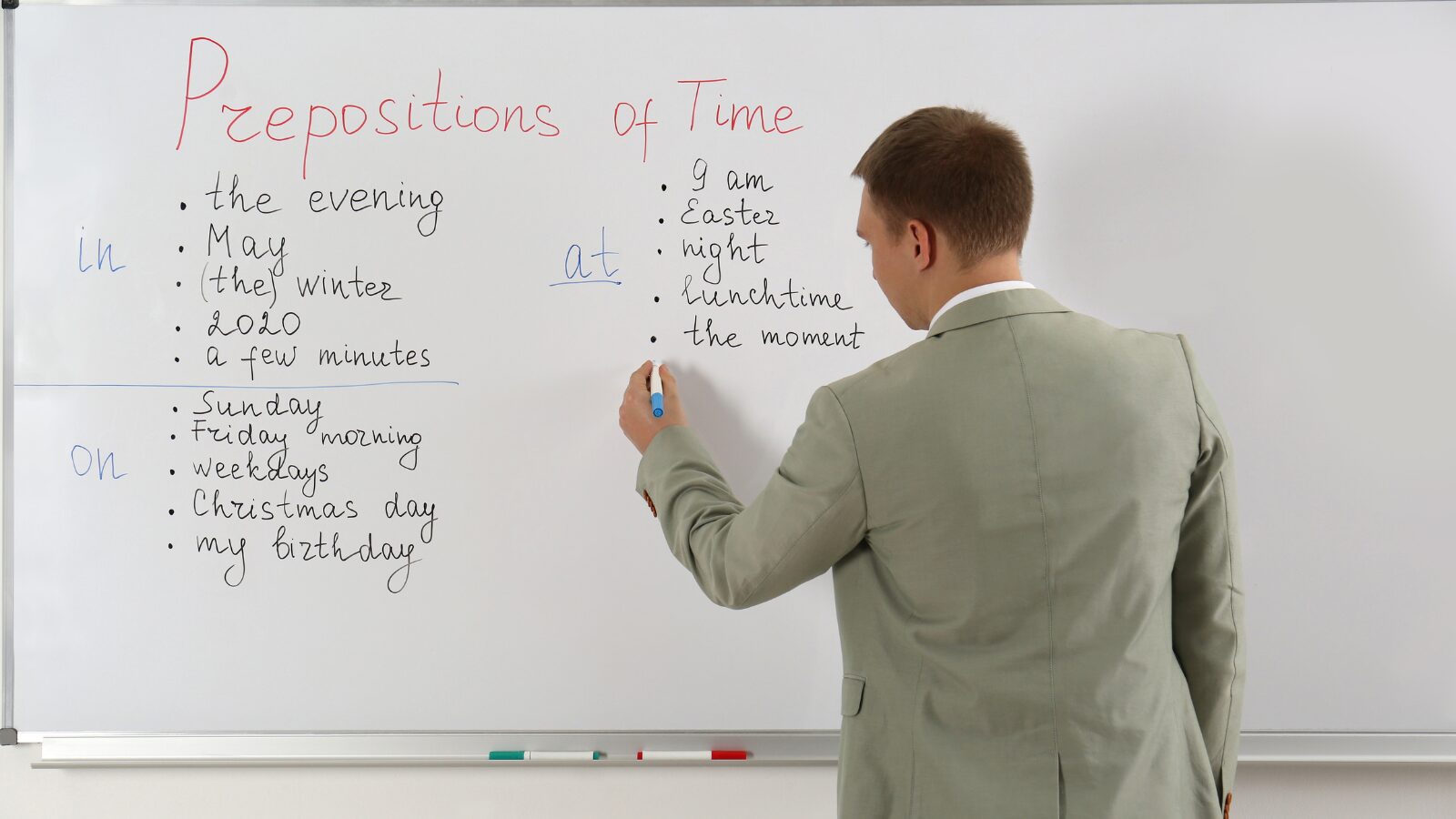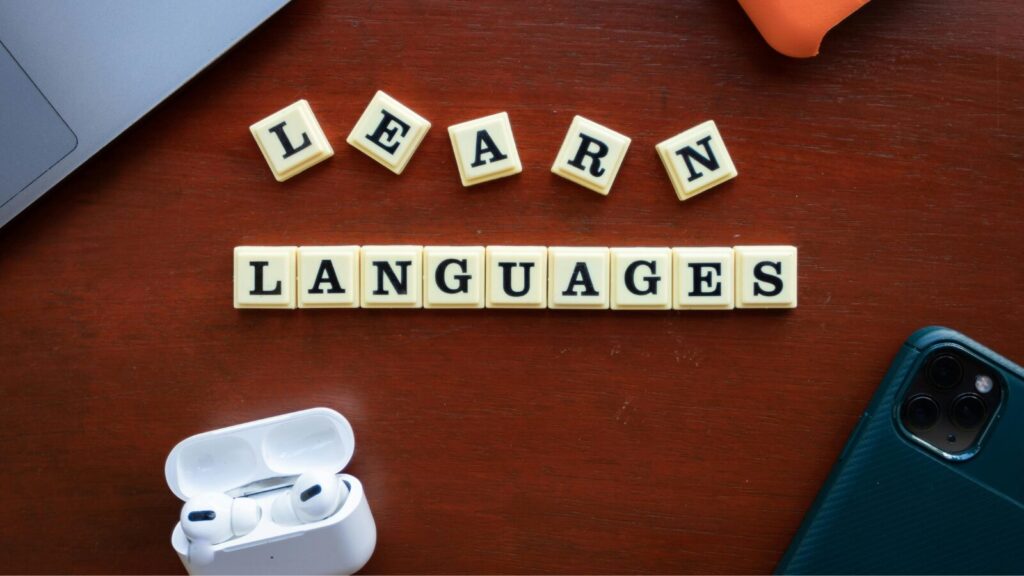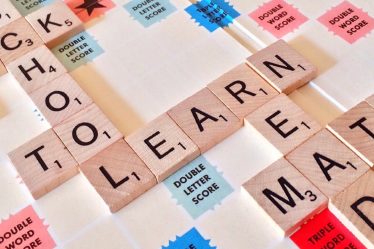
Prepositions are essential words or phrases in English that link nouns, pronouns, or noun phrases to other parts of a sentence. They are crucial in showing relationships by providing details about time, place, direction, cause, or manner.
The Cambridge Dictionary defines a preposition as “a word that connects a noun, a noun phrase, or a pronoun to another word, especially to a verb, another noun, or an adjective.”
Role of Prepositions in Sentence Structure
Prepositions are fundamental in organizing sentences clearly by showing how different parts relate. They usually come before nouns or pronouns and are often followed by a complement to create prepositional phrases.
For example, in the sentence “The book is on the table,” the preposition “on” connects the noun “book” to its location, “table.”
Prepositions define the relationships between parts of a sentence and provide important details. They can describe:
- Time: “The class starts at 9 a.m.”
- Place: “He is in the room.”
- Direction: “She moved towards the door.”
- Cause or Manner: “He succeeded through hard work.”
In the sentence “She walked to the park,” the preposition “to” introduces the phrase “to the park,” which indicates the direction of her movement.
Prepositional Phrases
A prepositional phrase includes a preposition, an object (a noun or pronoun), and modifiers. These phrases add depth by giving extra information in sentences. For example, in “The keys are under the couch,” the prepositional phrase “under the couch” describes the location of the keys.
Prepositions are often idiomatic, meaning their use is based on fixed expressions rather than strict rules. For instance, we say “interested in” but not “interested on.” Learning these fixed expressions is necessary to use prepositions correctly in English.
Exploring the Types of Prepositions
Prepositions are essential components of the English language that show relationships between words in a sentence. They can be grouped based on their functions, including relationships related to time, place, direction, or cause.
Explore more blogs on learning English.
Prepositions of Place
Prepositions of place indicate the location or position of a person or object in relation to something else. They answer “where” questions in a sentence, helping to create a clear mental image of spatial relationships.
Examples:
- “The keys are on the table.”
- “He sat under the tree for shade.”
- “The painting hangs above the fireplace.”
- “The car is parked next to the building.”
These prepositions make it easy to describe the location of objects in space, whether on a surface, beneath something, or in relation to other objects.
Prepositions of Time
Prepositions of time tell us when something happens. They answer “when” questions and are often used with dates, times, or specific periods. These prepositions help organize events chronologically and provide context for when actions occur.
Examples:
- “She was born in December.”
- “The meeting is scheduled at 3 p.m.”
- “We will visit them on Saturday.”
- “He stayed home during the holidays.”
Using these prepositions, you can precisely describe when events occur, whether it’s a specific moment, day, or period.
Prepositions of Direction/Movement
Prepositions of direction or movement show the motion of a person or object from one place to another. They answer “where to” or “from where” questions and help describe actions that involve changes in position or location.
Examples:
- “He walked to the park.”
- “The athlete jumped over the hurdle.”
- “She is traveling from Paris to London.”
- “The cat leaped onto the bed.”
These prepositions are particularly useful when describing journeys, sports activities, or any action involving movement.
Prepositions of Manner, Cause, or Instrument
This category of prepositions describes how, why, or by what means an action happens. They add important details about the manner, reason, or tools used, helping paint a more complete picture of the described action or situation.
Examples:
- “She spoke with confidence.”
- “The project succeeded because of their teamwork.”
- “He painted the wall using a brush.”
- “The guests were delighted by the performance.”
These prepositions are particularly useful for explaining abstract concepts like reasons, emotions, and methods, adding depth to your descriptions.
Compound Prepositions
Compound prepositions consist of more than one word but function as a single unit. They often provide more specific or nuanced meanings than single-word prepositions, allowing for greater precision in language.
Examples:
- “The car stopped in front of the house.”
- “She stayed home because of the storm.”
- “The team played well on behalf of their coach.”
- “He is standing in between the two chairs.”
Compound prepositions allow you to add more detail and specificity to your sentences, making your communication more precise and engaging.
Mastering Prepositions
Understanding and correctly using these different types of prepositions can significantly enhance your English language skills. Here are some tips to help you master prepositions:
- Context is key: The meaning of a preposition can change depending on the context. Pay attention to how prepositions are used in different situations.
- Practice with real-life scenarios: Try describing your surroundings, daily activities, or travel plans using various prepositions.
- Read extensively: Exposure to prepositions in context through reading can help you internalize their correct usage.
- Use visual aids: Diagrams or pictures can help reinforce understanding of prepositions of place and direction.
- Learn common phrases: Many prepositions are part of fixed phrases or idioms. Learning these as complete units can be helpful.
- Be aware of differences: Preposition usage can vary between different varieties of English (e.g., British vs. American English).
- Don’t always translate directly: If English is not your first language, be cautious about directly translating prepositions from your native language, as usage often differs.
By focusing on and practicing these different types of prepositions, you can significantly improve your ability to express spatial relationships, temporal sequences, movement, and abstract concepts in English.
Remember, like many aspects of language learning, mastering prepositions takes time and practice. Don’t be discouraged if you make mistakes; view them as opportunities to learn and improve your language skills.
Avoiding Common Preposition Mistakes
Prepositions are a key part of English sentences, but they can be tricky for learners to use correctly. Mistakes with prepositions can cause confusion or miscommunication. Below are the most common preposition errors and tips and examples to help you avoid them. Also, learn about common grammar mistakes.
Unnecessary Prepositions
Adding extra prepositions can make sentences awkward or repetitive. For example, in the question “Where are you at?” the word “at” is unnecessary because “where” already asks about location. The correct sentence is “Where are you?” Similarly, “She entered into the room” is redundant. You should say, “She entered the room.”
Tip: Leave out prepositions in sentences when the meaning is already clear without them.
Preposition Confusion
Mixing up prepositions that look similar but mean different things is common. For example, some people say “interested on music” instead of “interested in music.” Another frequent mistake is saying “discuss about” instead of “discuss.”
Example Corrections:
- Incorrect: “She is good in math.”
- Correct: “She is good at math.”
- Incorrect: “This depends of the weather.”
- Correct: “This depends on the weather.”
Tip: Learn the specific combinations of verbs and adjectives with prepositions to use them correctly.
Overgeneralization
Trying to apply one preposition rule to all situations often leads to mistakes. For example, “on Monday” is correct, but saying “on January” is wrong. The correct phrase is “in January.”
Example Corrections:
- Incorrect: “I was born on February.”
- Correct: “I was born in February.”
Tip: To avoid this mistake, study how prepositions are used in different contexts, such as time, place, and direction.
Ending Sentences with Prepositions
In informal English, ending sentences with prepositions is becoming more acceptable. However, in formal writing, you should usually rephrase the sentence. For example, instead of “This is the person I spoke with,” you could write, “This is the person with whom I spoke.”
Example Corrections:
- Informal: “What are you talking about?”
- Formal: “About what are you talking?”
Tip: In formal situations, rearrange sentences so prepositions appear earlier, improving clarity and following traditional grammar rules.
Misuse with Phrasal Verbs
Phrasal verbs need specific prepositions to convey their correct meanings. Changing the preposition can change the entire meaning of the phrase. For example, “look after” means caring for, while “looking into ” means investigating.
Example Corrections:
- Incorrect: “I will look after the problem.”
- Correct: “I will look into the problem.”
Tip: Pay close attention to the prepositions used with phrasal verbs since their meanings often depend on the specific combination of words.
Translating Directly from Other Languages
Learners who speak multiple languages often make preposition mistakes by translating directly from their native language. Prepositions in English don’t always match those in other languages. For instance, instead of saying “married with,” you should say “married to.”
Example Corrections:
- Incorrect: “She is married with a doctor.”
- Correct: “She is married to a doctor.”
Tip: Learn how prepositions are used in context rather than relying on direct translations from your native language.
Effective Strategies for Teaching Prepositions
Successful preposition teaching requires engaging, practical methods that help students understand and use these key parts of English grammar. Below are strategies designed for educators to make preposition lessons interactive and meaningful.
Introducing Prepositions Gradually
Start by teaching prepositions in small, manageable groups. Begin with the most common ones, such as “on,” “in,” and “at,” before moving to more complex ones, such as “beneath,” “between,” and “through.” Define prepositions as words that show relationships related to time, place, direction, or manner.
Use visual examples to make the concept clearer. Demonstrate where an object is in relation to another using real-life examples:
- “The book is on the table.”
- “The keys are under the chair.”
This step-by-step approach ensures students are not overwhelmed with information and allows them to build a strong foundation before tackling more challenging examples.
Using Visual Aids
Visual aids are excellent tools for helping learners understand spatial relationships. Utilize diagrams, flashcards, and real objects to explain prepositions. For instance, show pictures of a cat positioned “on,” “under,” “next to,” or “inside” a box to clarify these concepts visually.
Interactive tools, such as digital whiteboards or physical objects in the classroom, can make lessons more engaging. For example, place a toy under a chair and have learners describe its location using the correct preposition. These visual aids strengthen understanding and help students remember abstract concepts.
Interactive Games
Games make learning more enjoyable and memorable. Incorporate activities like “Preposition Bingo,” where students match prepositions to images, or scavenger hunts that involve using prepositions to follow clues. Other effective games include:
- Preposition Memory Game: Show a picture briefly, then ask students to describe where objects are using prepositions.
- Hands-on Practice: Give instructions like “Place the pencil on top of the notebook” or “Move the eraser beside the book.”
These games actively involve students and provide opportunities to practice prepositions in fun and practical ways.
Contextual Learning
Teaching prepositions through real-life situations helps students relate to the material. Use examples from daily life, such as “The bus arrives at 8 AM” or “The park is behind the school.” Encourage students to create their examples based on their experiences.
Reading passages or listening exercises that include prepositions in context also help learners understand their usage. For example, give students a passage like:
“During the trip, we stopped at a restaurant on the highway. The restaurant was located next to a gas station.”
Ask them to find and analyze the prepositions in the passage to reinforce their understanding.
Addressing Common Challenges
When teaching prepositions, be aware of common difficulties students may face:
- Language Interference: Students might try to translate prepositions directly from their native language, which can lead to errors. Address this by emphasizing the unique usage in English.
- Idiomatic Expressions: Many prepositional phrases in English are idiomatic and don’t follow logical patterns. Teach these as fixed expressions and provide plenty of practice.
- Preposition Combinations: Some verbs and adjectives require specific prepositions. To help students memorize these combinations, create focused exercises.
- Overuse or Underuse: Some languages use prepositions more or less frequently than English. Help students understand when prepositions are necessary in English and when not.
Read about commonly confused english words.
Practice Makes Perfect: Preposition Exercises
Preposition exercises improve your understanding of these essential parts of English grammar. They are designed to strengthen your skills and pinpoint areas that need improvement. Below are three types of activities—fill-in-the-blank sentences, error correction tasks, and matching exercises—that effectively teach prepositional usage.
Fill-in-the-Blank Sentences
Fill-in-the-blank exercises test your ability to choose the correct preposition based on the context. These sentences focus on prepositions related to place, time, and direction.
- The keys are ___ the table. (Answer: on)
- She was born ___ December. (Answer: in)
- The dog ran ___ the park to catch the ball. (Answer: through)
- We will meet ___ noon at the café. (Answer: at)
Error Correction Tasks
Error correction tasks challenge you to identify and fix mistakes in prepositional usage. This activity helps you refine your grammar and develop a sharper eye for detail.
- Incorrect: I will meet you in Monday.
Correct: I will meet you on Monday. - Incorrect: The train arrived at time.
Correct: The train arrived on time. - Incorrect: He is good in math.
Correct: He is good at math. - Incorrect: She is interested on art.
Correct: She is interested in art.
Matching Activities
Matching exercises allow you to pair prepositions with the correct phrases or contexts. This activity helps you learn fixed expressions and prepositional collocations.
Match the preposition to its correct usage or phrase:
- ___ the bus stop a. in
- ___ Monday b. at
- ___ the river c. on
- ___ confidence d. by
Answers: 1-b, 2-c, 3-a, 4-d
Tutoring for English Grammar
If you’re looking to master prepositions in the English language, you might consider seeking specialized tutoring to enhance your skills. A simple search like “English language tutor for prepositions” on platforms like meet’n’learn can connect you with experienced private tutors who can tailor lessons to your needs.
If you prefer a group learning environment, searching for “English grammar classes near me” or “prepositions lessons in [your location]” can lead you to local educational centers or community colleges that offer structured classes.
Whether you want one-on-one tutoring or group sessions, meet’n’learn provides a wide range of options to help you effectively master prepositions and improve your overall command of the English language. Don’t hesitate to explore the resources available on the site to find the perfect match for your learning style!



